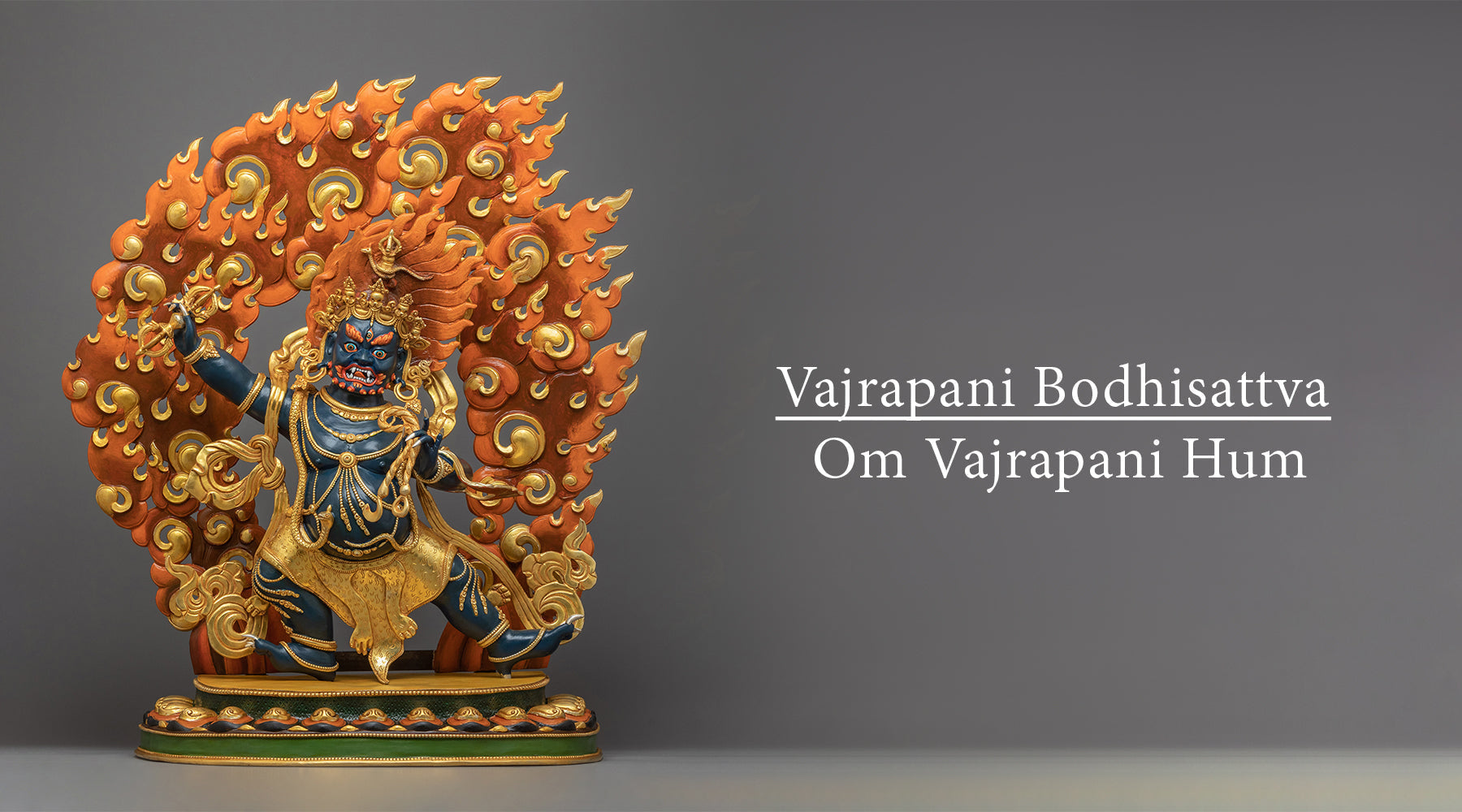Who is Vajrapani Bodhisattva?
Vajrapani also a Bodhisattva is a member of Akshobhya Buddha's Vajra Family. "Om Vajrapani Hum" is his mantra. Vajrapani embodies all the buddhas' boundless power and is the first deity to be depicted in a wrathful form in this series.
The word Vajrapani, which means "Vajra-handed," has a long history and is mentioned in the Rig Veda (about 1500 B.C.E.) as an epithet of Indra. The phrase is primarily used in the Vedic context to refer to Indra as a weapon bearer. Since it is with his vajra (a lightning bolt) that Indra fights the demons, foes, and those that challenge the Aryans. Because of his ties to rain-controlling nagas and with the Hindu god of rain, Indra, he is invoked in times of drought.
Vajrapani Statue
Vajrapani Buddha's head, which is much larger than his body, is crowned with skulls and is by skulls headband. He stands on a sun disc, displaying four teeth and a wrathful visage. His brows, mustache, and beard are flame-shaped, and his long, flowing hair cascades wildly above. He is dressed in a loincloth that he wears around his hips. The tiger's skin was used to make the cloth.
He has a third eye in the center of his brow and is encircled by wisdom-energy flames coming from his mighty body's pores. His right hand's threatening gesture (tarjani mudras) is a global warning gesture. The Buddhist emblem of perfect truth, the rising vajra, is held in his right hand. With his left hand, he clutches Lasso.
He is not only adorned with jewels, but he is also encrusted with shakes of anger, which he controls by the superior force of his compassion.

Click here: Vajrapani Bodhisattva Statue
Vajrapani Buddha Mantra
What does Om Vajrapani Hum mean?
Vajrapani Buddha mantra Om Vajrayana Hum is his name, "wielder of the thunderbolt," with Om and Hum's mystical phrases enclosed between them.
Om is usually considered the first sound and even the sound symbol of reality itself. It represents the universal enlightenment principle.
Hum, which signifies the unique human being's manifestation of enlightenment. It might just be a coincidence, but hum sounds like the Sanskrit word "aham," which means "I."
Is Vajrapani Bodhisattva a protector?
Vajrapani reflects the strength required to conquer all afflictive feelings. He is a protector who offers us the power to develop despite our extensive and detrimental previous karmas. Vajrapani represents the discipline required to practice every day.
It takes the strength of a guardian, an angry ferocious power, to teach us how to conquer pride, greed, rage, hatred, and all the poisons. As a result, millions of people worldwide recite his tranquil mantra every day. He is a brave warrior in his mild form, ready to be our Hand of Protection and Strength. No impediment can stand against him in his wrathful state.
Is Vajrapani same as Vajrasattva?
Vajrasattva is an embodiment of peace. Vajrapani is the wrathful form. Vajrasattva rules all the buddha families and mandalas. Vajrapani is referred to as the "Protector of Buddha." He is one of the three significant Bodhisattvas in the Mahayana Sutra.
Vajrasattva is represented with a bell in his left hand and a Vajra in his right hand. The bell represents knowledge, while the vajra represents compassion. He rests serenely on a moon disc atop a lotus seat, his legs crossed. The lotus seat represents his willingness to stay in this impure cycle of samsara for the sake of sentient beings while being unblemished by its flaws.
Vajrapani stands atop a sun disc with four fangs and a vengeful expression. His long, flowing hair flows fiercely above his brows, mustache, and beard, flame-shaped. He wears a loincloth across his hips. The fabric is made from the skin of a tiger. His right hand's threatening gesture is a global warning gesture with vajra and Lasso on his left hand.
Vajrapani Buddha Story
The Digha Nikaya, a Buddhist book, contains a tale of Buddha and his disciple Vajrapani. Ambattha, a Brahmin, treats the Buddha unpleasantly and disrespectfully. He thought Buddha to be from a lower social caste. He then refuses to answer a question concerning his origins that the Buddha questioned. Despite the Brahmin's hostility, the Buddha is quite respectful.
After Ambattha refuses to answer the question twice, Buddha reminded him of the old belief. The belief was if you fail to answer an enlightened one's question three times, your head will break into seven parts.
After that, Vajrapani appeared, who is the pali form of Buddha's name. He then prepared to fulfill the historic promise. The statement made Ambattha frightened and responds quickly to the Buddha's question.
Vajra Anuchara origin through Vajrapani Bodhisattva
The origin of Vajra Anuchara is explained in a 9th-century Nepalese paper titled Sarva-tathagata Vajra-Samaya Mahakalpa-raja on Maheshvara's (Shiva's) conversion.
"Do you not accept my commands?" questioned Vajrapani, the Great Bodhisattva, staring at Mahadeva. "I would choose death rather than heed your demands," Mahadeva exclaimed, blazing with anger and displaying his vast wrathful form after hearing Vajrapani words. The Mighty Bodhisattva Vajrapani drew out from the soles of his feet. OM PADA AKARSHANA VAJRA HUM, displaying his significant wrathful aspect. Vajra Anuchara, surrounded by flames and with [bared] fangs and a frowning forehead, appeared from the soles of his feet and stood before Vajrapani, awaiting his order.
Vajrapani said: OM PADA AKARSHAYA SARVA VAJRA DHA... VAJRA HUM to thoroughly cleanse Mahadeva. Mahadeva, once again drawn to Vajrapani feet by Vajra Anuchara's "foot attraction," with feet in the air, bare, and becoming an object of laugh for everybody.





